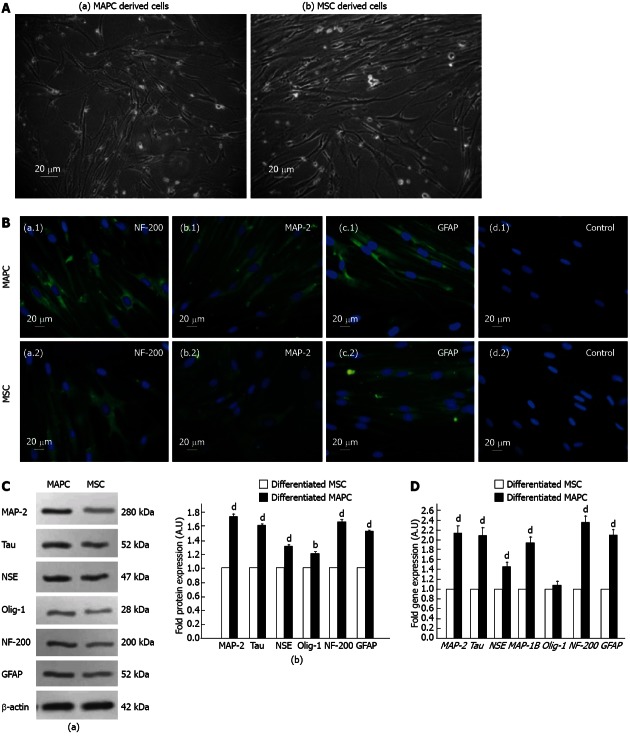Figure 3.
Neural differentiation potential of multipotent adult progenitor cells and of mesenchymal stem cell. A: Representative photomicrographs (×10, 20 μm) of neuronal cells differentiated from (a) multipotent adult progenitor cells (MAPC), and (b) mesenchymal stem cell (MSC); B: Representative immunocytochemical photomicrographs (×40, 20 μm) showing an overlay of fluorescein isothiocyanate (FITC) and Hoechst staining for (a.1 and a.2) neuronal filament-200 (NF-200), (b.1 and b.2) microtubule-associated protein 2 (MAP-2), and (c.1 and c.2) fibrillar acidic protein (GFAP) expression in neuronal cells differentiated from MAPC and MSC, respectively. Negative control represents cells with no treatment with neurogenic medium (d.1) MAPC and (d.2) MSC; C: Immunoblots analysis of neural proteins in MAPC and MSC derived neuronal cells. (a) Representative immunoblots of MAP-2, Tau, neuron-specific enolase (NSE), oligodendrocyte-1 (Olig-1), NF-200 and GFAP proteins in MAPC and MSC derived neuronal cells; (b) Error-bar diagrams showing fold change expression of proteins in MAPC (solid bars) and MSC (open bars) derived neuronal cells as revealed by densitometric quantification of immunoblots. bP < 0.01, dP < 0.001 vs MSC group; D: Error-bar diagrams showing expression of MAP-2, Tau, NSE, MAP-1B, Olig-1, NF-200 and GFAP genes in MAPC (solid bars) and MSC (open bars) derived neuronal cells as revealed by real-time quantitative polymerase chain reaction. The values of MSC and MAPC treated with neurogenic medium and their untreated counterparts were normalized to housekeeping glyceraldehyde-3-phosphate dehydrogenase and the fold increase values of MAPC compared to MSC have been expressed as mean ± SE, bP < 0.001 vs MSC group.

